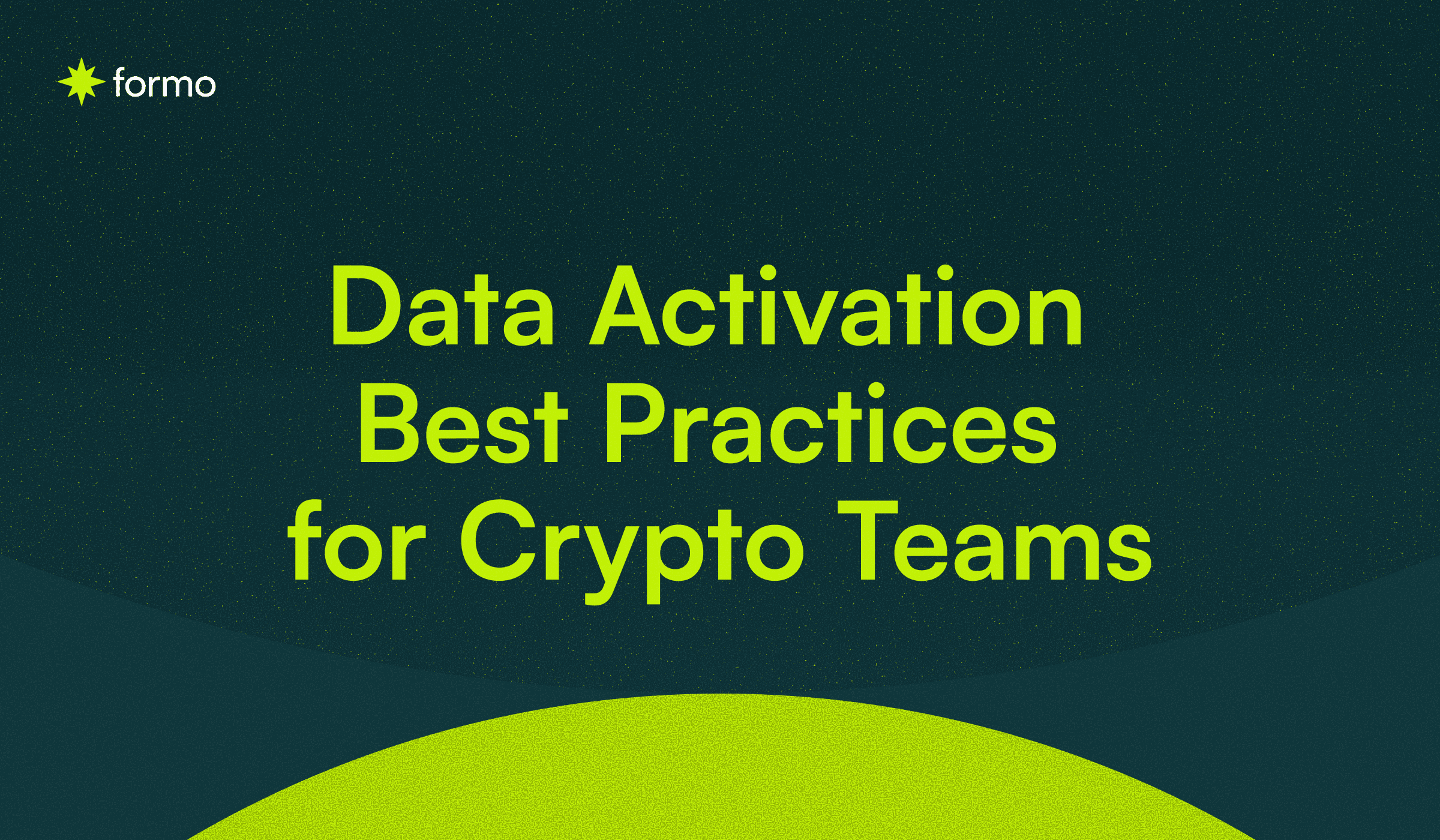Title: Web3 Growth Stack Explained: Tools, KPIs & Strategies for Onchain Growth
Currently, over 125 startups are working to provide solutions to support some of the world’s most innovative companies, ecosystems, and brands as they navigate Web3 growth. As the world becomes increasingly digitized, the Web3 Growth Stack has emerged as a key innovation in the digital landscape. In this article, we will explore the Web3 growth stack, examining the technology, key players, and trends shaping the future of the Internet.
Key takeaways
Web3 Growth Stack replaces Web2 tools with crypto-native solutions for acquisition, engagement, and retention.
Web3 user acquisition uses onchain data and new ad formats like cost-per-transaction.
Engagement & retention are driven by onchain identity, attribution, quests, and reward mechanisms.
Understanding users is central—combining on/offchain data improves growth strategies.
Top tools include Galxe, Layer3, Boost, XMTP, Collab.land, and Formo.
What Is the Web3 Growth Stack?
The Web3 Growth Stack includes the tools and platforms that product managers and marketers use to acquire, engage, and retain users (utilizing Web3 technologies).
The MarTech category has grown exponentially - an increase of up to 6,571%, from 150 to over 9.9 thousand companies between 2011 and 2022.

Brinker, S. Growth of the Martech Landscape 2011-2022. Source: chiefmartech.com
These tools (e.g., CRM/MarTech software) help brands and startups manage key activities, including demand generation, user engagement, conversion measurement, monetization, and customer satisfaction. Unfortunately, many Web2 growth tools are inadequate for the needs of crypto and Web3 brands. Marketing automation and customer interaction tools such as Hubspot and Klaviyo do not account for onchain activities and events. Product analytics and attribution platforms such as Posthog and Mixpanel lack blockchain data.
Worse still, no one has combined in-app activity with programmable payments, one of the biggest opportunities in web3 growth. As a result, Web3 developers are often left "fumbling in the dark," falling behind in the battle for user attention online.
This is starting to change. As we enter 2024, the Web3 Growth Stack is undergoing rapid development, driven by the integration of core crypto primitives, such as onchain attribution and identity, and native bi-directional value flow.
Web3 Growth Statistics
Web3 is scaling fast with the numbers to prove it and a Web3 growth rate that signals sustained momentum:
By Bitcoinke, 21,300 monthly active developers contributed to open-source Web3 projects in 2023, showing strong momentum in innovation.
In Q1 2023, 108 startups raised $814M, with DeFi (26%) and developer tooling (25%) leading the funding focus.
The Web3 market cap is $27.5B, with forecasts projecting a $5.5B global market size by 2030, growing at a 44.9% CAGR.
These trends signal a developer-driven, VC-backed, infrastructure-first movement reshaping the internet. As platforms like Formo emerge, the Web3 Growth Stack is set to power the next wave of user acquisition, retention, and decentralized growth.
The Web3 Growth Funnel
To better understand the impact of Web3 ideas on the industry, it's critical to examine each part of the Web3 growth funnel. We'll start with user acquisition and then move on to engagement and retention.

The Web3 Growth Funnel
Web3 User Acquisition
User acquisition refers to the process of finding, acquiring, and activating new users for a product. In the Web3 ecosystem, user acquisition relies on advanced targeting and segmentation, supported by the combination of onchain data with offchain information. This approach delivers more accurate targeting and a better user experience.
Moreover, Web3-enabled ad units allow users to earn rewards or purchase directly within ads without leaving the publisher's page. This revolutionizes core advertising metrics, transforming cost-per-click (CPC) and cost-per-impression (CPM) models into cost-per-transaction models.
Beyond advertising, direct outbound marketing also benefits from Web3 technology integration. Address-to-address messaging through protocols such as Dialect, XMTP, and Nansen Connect enables Web3-native lifecycle marketing, allowing you to reach high-value users.
Web3 User Engagement
Web3 growth analytics and engegament tools are critical for understanding user behavior and making impact decisions about product improvement. Crypto-native teams such as Spindl.xyz and Boost.xyz are developing solutions that combine Web2 engagement tools with onchain attribution and identity. By linking granular in-app actions to onchain personas, product teams can identify inflection points in the product lifecycle and more effectively address issues like Sybil attacks.
Web3 User Retention
Retaining users is often more cost-effective than acquiring new ones, making it a crucial aspect of the growth funnel. Onchain identity and attribution data help product teams develop stronger incentive models and improve user loyalty. Quest platforms such as Galxe, Layer3, and Gitcoin leverage onchain credentials, airdrops, and token-gated events to engage and retain users. Additionally, these brands are exploring ways to incentivize users through rewards and ownership.
Understanding Users — The Key to Growth in Web3
Although Web3 has experienced growth in recent years, the competitive landscape is fierce, leading to high attrition rates. Around 40% of the 4,000 DApps listed on Defilama appeared between 2020 and 2021 but disappeared after just one or two years. The constant challenge of attracting new users and keeping them engaged with products is a puzzle for brands in both Web2 and Web3. The key to sustainable growth lies in a thorough understanding of your users.
User insights and their preferred online destinations are important for Web3 projects to build effective strategies for attracting new users. By examining user journeys and funnels from offchain channels such as social media, quest platforms, and landing pages to onchain smart contracts, Web3 projects can optimize their marketing campaigns.
In-depth research into user behavior within your products and other Web3 ecosystems can provide valuable insights to improve the user experience and drive growth.
Challenges and Opportunities in the Web3 Growth Stack
As the Web3 Growth Stack gains traction, brands and developers need to navigate challenges and opportunities in this emerging landscape:
Challenge | Opportunity |
Scalability | Layer-2s (ZK Rollups, Optimistic Rollups) to lower gas costs |
Regulatory uncertainty | Build with compliance in mind (e.g., KYC-optional flows, opt-in data) |
Lack of standard tooling | Opportunity to define the standard for Web3 marketing |
Tokenomics complexity | Create smart, sustainable incentive systems that align with growth |
Scalability: With more users and applications adopting Web3 technology, effective scalability becomes increasingly important. Layer-2 solutions such as Optimistic and ZK Rollups can help address scalability concerns, enabling faster transactions and lower costs.
Regulation and Compliance: The Web3 growth industry faces a complex and evolving regulatory landscape that varies by jurisdiction. Brands must navigate these legal challenges while ensuring compliance with existing and emerging laws, including user privacy, data protection, and anti-money laundering (AML) requirements.
Tokenomics: Tokenizing digital assets and services is a critical part of the Web3 Growth Stack. Brands must carefully design tokenomics models to ensure sustainability and create value for users.
Ecosystem Collaboration: The Web3 Growth Industry is marked by rapid innovation and competition. To thrive, brands must actively engage with the broader ecosystem, collaborating with other projects, developers, and users to build partnerships and drive collective growth.
Web3 Growth Stack: Brands and Areas to Watch
Here are some of the leading players in each field:

The common categories of Web Growth Stacks
1. Loyalty Platforms
Blackbird: Enhances customer loyalty through wallet-based rewards.
Token Proof: Verifies wallet ownership to unlock loyalty rewards.
2. Quests
Layer3: Gamify user engagement with interactive quests.
Galxe: Empowers brands to create quest-driven growth campaigns.
Boost: Rewards users for completing tasks and quests onchain.
4. Community Tools
Collab.land: Manages community memberships based on token ownership.
Jokerace: Hosts decentralized community-driven contests.
PartyDAO: Facilitates collective decision-making and participation in Web3 communities.
5. Messaging
XMTP: Enables secure, wallet-to-wallet messaging across platforms.
Push: Provides decentralized notifications for dApps and wallet users.
Dialect: Offers customizable onchain messaging solutions.
6. Social
Warpcast: Decentralizes social networking for Web3 communities.
Hey: Focuses on building privacy-centric social experiences.
7. Ad Networks
Hypelab: Provides onchain advertising solutions for dApps.
Slise: Focuses on Web3-native advertising with wallet-based targeting.
This category of software will replace the previous generation of MarTech tools, as it addresses many of the challenges startups face in the Web3 space.
Web3 Growth Analytics for Web3 Startups
Formo empowers Web3 teams to capture and analyze onchain data (DApps, contracts, etc.) and offchain data (social media, etc.) to create a comprehensive customer profile. With Formo’s Web3 Form Builder, Web3 product and marketing teams can better understand their users, gain a complete view of their product, target the right users at the right time, and achieve product-market fit.

Achieve product-market fit and drive growth with Formo’s Web3 Form Builder
The Web3 Growth Stack is an exciting development that brings great potential for both brands and users. By embracing this new paradigm, Web3 teams can unlock the transformative power of decentralization and create more user-centric digital experiences.
Further sources:
Follow Formo on LinkedIn and Twitter, and join our community for more onchain growth insights!
FAQs
1. How is Web3 growth different from traditional digital growth?
Web3 growth leverages blockchain-native features such as:
Wallet identity instead of email sign-ups
Onchain attribution instead of cookies
Token incentives and ownership models instead of discounts or loyalty points
Traditional digital growth (Web2) depends heavily on cookies, emails, and personal data, while Web3 emphasizes decentralized, pseudonymous, and verifiable user interactions.
2. What verticals benefit most from the Web3 Growth Stack?
The Web3 Growth Stack is particularly valuable for:
Gaming (play-to-earn, asset ownership, player economies)
DeFi protocols (onchain attribution, liquidity growth)
DAOs (member activation and retention)
NFT projects (drops, secondary sales, collector engagement)
Decentralized social platforms (wallet-based identity and engagement)
Any vertical where identity, engagement, and loyalty are critical in a decentralized context can benefit.
3. What challenges do teams face when adopting Web3 growth tools?
Common challenges include:
Data fragmentation across multiple chains and platforms
Steep learning curve for teams new to crypto-native concepts
Measurement gaps, since traditional analytics don’t apply to wallets
Balancing incentives with long-term retention
Modern Web3 analytics tools—like Formo—help solve these challenges by unifying cross-chain insights and making wallet-level analytics accessible to growth and product teams.
4. What KPIs are unique to Web3 growth teams?
Some Web3-specific KPIs include:
Wallet activation (unique wallets connecting to your app)
Feature adoption rate (wallet-level product usage)
Cost-per-wallet (CAC for wallet users)
Onchain retention (returning wallets across chains)
Revenue-per-wallet (RPW) (onchain revenue generated per user)
These metrics help growth teams measure true wallet-level performance instead of relying on traditional Web2 user tracking.
5. How do I get started building a Web3 growth strategy?
To launch your Web3 growth strategy:
Integrate analytics tools like Formo that unify onchain and offchain insights.
Define your funnel (wallet activation → engagement → retention).
Identify key wallet behaviors that correlate with value.
Use wallet messaging and token incentives to drive adoption.
Continuously measure attribution and iterate based on wallet-level analytics.
A strong Web3 growth strategy blends product analytics, community building, and ownership-based incentives into one ecosystem.





